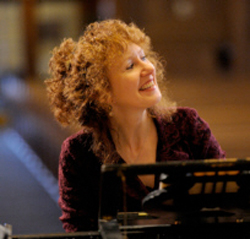by Daniel Hathaway
Fifty
The Cleveland Orchestra has already successfully done this by inviting Bernard Labadie and Ton Koopman to guest conduct the ensemble. Last Saturday evening at E.J. Thomas Hall in Akron, the Akron Symphony welcomed Apollo’s Fire founder and artistic director Jeannette Sorrell to lead music by J.S. Bach and Handel with the assistance of AF’s concertmaster Olivier Brault. As usual for these occasions, the strings were reduced to chamber orchestra proportions to obtain a leaner, lither sound.
Sorrell chose delightful, ingratiating music for Akron: the first and fifth “Brandenburg” concertos and selections from Water Music (with a movement from the Music for the Royal Fireworks tucked in), beginning each half of the concert with a concerto and following up with movements from Handel’s al fresco suites. Sorrell’s work with the orchestra musicians on points of style and technique brought fine results to this special repertory.
Brandenburg No. 1 got things off to a jubilant start with lively tempos and sprightly trading of motives between horns, oboes and bassoon and strings. Sorrell conducted with a baton from the podium, turning continuo keyboard duties over to harpsichordist Robert Mollard. Brault stood to play the solo fiddle part on a violino piccolo — a small version of that instrument meant to be tuned up several notes higher than normal, and which up against modern strings finds itself at something of an acoustical disadvantage. Much of Brault’s virtuosic passagework got lost as a result, but the horns and double reeds sounded splendid.
We know the occasion for which Handel wrote his Water Music — a royal Georgian barge trip down the Thames in July of 1717 witnessed by a daily newspaper and a Prussian diplomat — but because no autograph score survives, the various pieces in the collection have been organized into suites according to key by later editors. Most modern performances start with pieces in F (with horns, oboes and bassoon), continue to pieces in G (for flute and strings, probably played indoors) and end with pieces in D (with trumpets, horns, oboes and bassoon). Sorrell chose two movements in G to begin, then played a set of the pieces in F.
Once again, tempos were frisky and engaging, though the famous Air to which many brides have glided down the aisle nearly turned into a gigue. Strings, horns and winds distinguished themselves in lucid and joyous playing.
After intermission, the harpsichord was swung around and the stage reset for Bach’s fifth Brandenburg. Here, Olivier Brault took the leadership role. He, along with harpsichordist Jeannette Sorrell and flutist Barbara O’Brien, the other two members of the solo trio, were surrounded by a smaller string orchestra, all standing but the cellists.
Brault set a brisk tempo for the opening Allegro, flexible enough to allow phrases to relax, then to regather momentum for tuttis. Sorrell had the white knuckle role to play in this movement, with the solo harpsichord’s digital flights of fancy and long, dramatic cadenza. Though a bad page turn led to a moment’s confusion, she brought her solo part off with fluency and admirable accuracy. Slightly enhanced with a guitar amplifier, the harpsichord sound nicely matched the violin and flute. The orchestra responded fluently to nuances in the soloists’ phrasing even when some of those details seemed mannered.
The slow movement belongs to the solo trio (plus cellist Miles Richardson), who played with lovely tone and expression. The final Allegro tore off at a “catch me if you can” pace, but everyone arrived neatly at the finish line after an exhilarating chase.
Flawless trumpeting from Scott Johnston and John Brndiar, robust, golden horn calls from Meghan Guegold and Cynthia Wulff and the cheerful, reedy contributions of oboists Terry Orcutt and Cynthia Warren and bassoonist Todd Jelen crowned the expert string playing in the D major suite that ended the concert. I had only two regrets.
The oboes and bassoon weren’t seated front and center (they were separated behind violins and cellos) where they could have added more color when doubling the strings and where they could have heard each other better (they often play as a trio — and did so admirably even when separated).
No. 2, there were no timpani on hand for the Handel suite in D. Indeed, there aren’t any extant drum parts and drummers weren’t mentioned in the eyewitness accounts in 1717, but neither were any river-faring harpsichords. Trumpets and drums went together during the baroque period like a horse and carriage, and the latter would only have added to the festive mood on Saturday evening. An enthusiastic ovation indicated that the audience was delighted.
Published on ClevelandClassical.com February 12, 2013
Click here for a printable version of this article.



